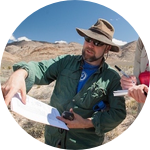Please wait...
About This Project
Joshua trees are perhaps the strangest plants in the world. Their long, spindly branches form twisted candelabras that have become an iconic image of the western American landscape. Ecological modeling suggests that global warming could drive Joshua trees to extinction. We propose to sequence the Joshua tree genome. This powerful research tool will help identify genes that have allowed Joshua trees to adapt to desert environments, and which could help them survive climate change.

Browse Other Projects on Experiment
Related Projects
How do polar bears stay healthy on the world's worst diet?
Polar bears survive almost entirely on seal fat. Yet unlike humans who eat high-fat diets, polar bears never...
Uncovering hidden insect diversity associated with a likely undescribed gall-forming midge
Does a likely undescribed species of gall-forming midge (pers. comm. Ray Gagné) on Eriodictyon plants (Yerba...
Macrofungi of the California archipelago
The eight islands of the California Archipelago are a well-studied biodiversity hotspot — but we know almost...





